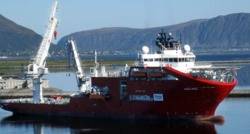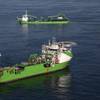World's Longest Offshore LNG Pipe – Divers Ready
‘Skandi Arctic’ is preparing to weld together the largest export gas pipe on the seabed ever built
The gigantic Nord Stream pipe, with two same-sized parallel ones, runs from Vyborg in Russia through the Gulf of Finland and the Baltic Sea to Lumina in Germany.
It will be able to secure supplies of electricity and heat to 26 million households in Europe for 50 years to come. The 1,224 kilometre-long pipe (approximately 760 miles) is currently located on the bottom in three lengths. Norwegian subsea expertise will be called upon to weld together the lengths of pipe on the seabed.
The gas pipes’ diameters are 48 inches, thus making it larger than any other one placed on the seabed to date.
Lifting the gigantic pipe sections with precision, which will be precisely cut and welded together with only a few millimetres clearance for the welding skate, requires heavy special equipment, which is currently stored and maintained at Statoil’s Pipeline Repair System (PRS) base in Haugesund. From there, a considerable amount of equipment, some of it heavy, for the welding job at depths of 80 and 110 metres (about 260 and 360 feet), will be loaded onto the ‘Skandi Arctic’.
The divers, who will work from within different pressure chambers in three to four weeks at a time, will have to descend onto the seabed to prepare the equipment for the welding operation.
They will also be required to stay down there in the deep whilst the remote-controlled welding machine carries out its 360-degree job around the circumference of the pipe.
With almost 400 tons of equipment and 140 people on board, the ‘Skandi Arctic’ will set sail from Haugesund for the Baltic Sea. This is the first ship in a new generation of diving vessels where monitoring of all life support systems for divers in the chamber or in the deep is managed and monitored by computers.
On the seabed, a diver will be able to install a small workshop tightly connected to the welding skate between the lengths of pipes. Seawater will then be pressed out so that divers can work in ordinary working clothes without a diving suit. Welding will also take place on dry pipes.
The entire job is expected to last for almost two months.












